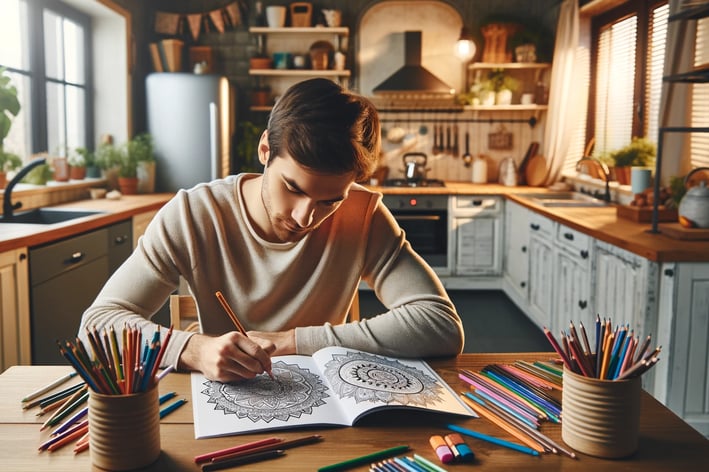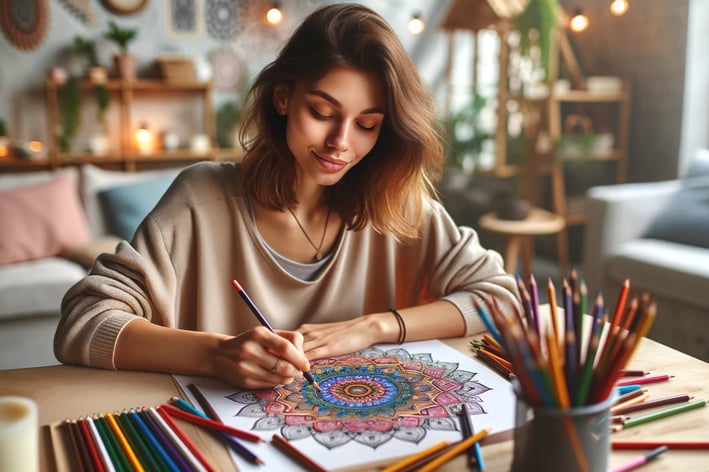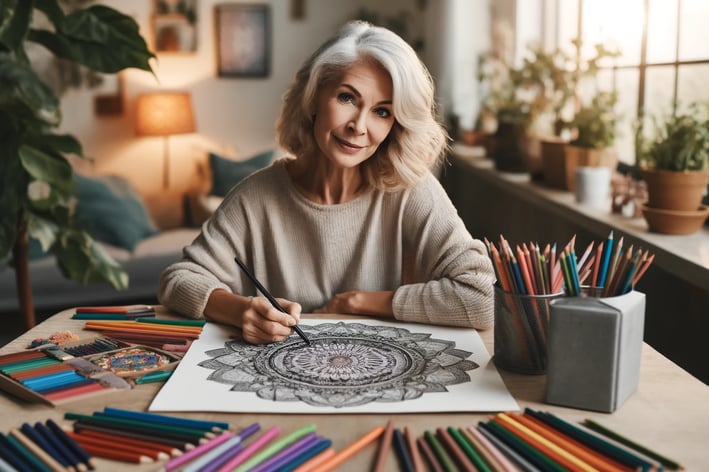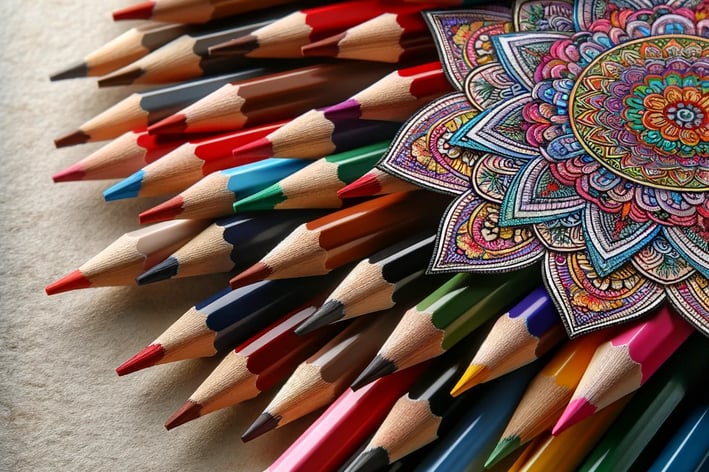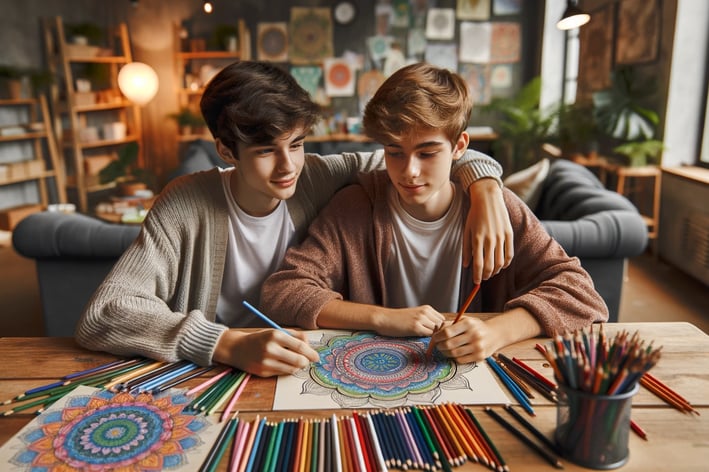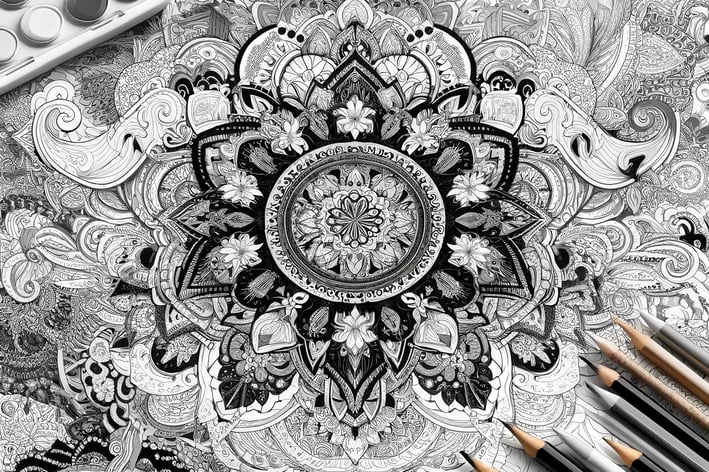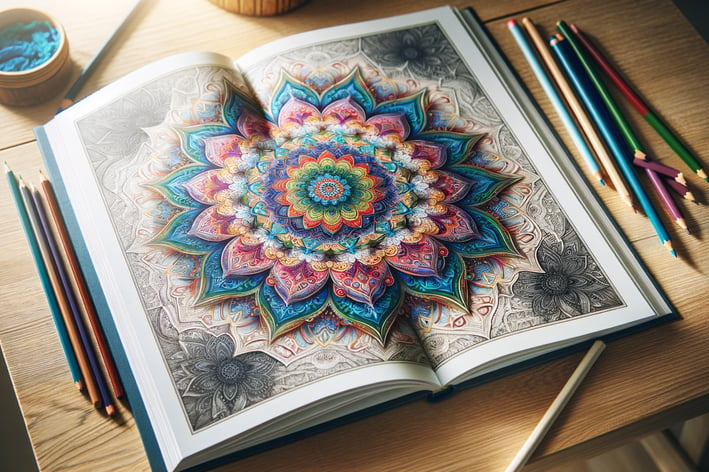PuzzlePlay Books
Unleash Your Inner Artist with Mandala Coloring
Discover the therapeutic art of mandala coloring and embark on a creative journey with our comprehensive guide. Explore the benefits of coloring intricate, symmetrical designs as an artist
PuzzlePlayBooks.com
6/10/20247 min read
Exploring Cultural Significance of Mandalas
Mandalas hold deep cultural and spiritual significance in various traditions around the world. In Hinduism, mandalas are used in rituals and meditation to represent the universe and the interconnectedness of life, often depicting deities within geometric patterns. Tibetan Buddhists create intricate sand mandalas as a form of meditation to gain a deeper understanding of the universe and the self, with the impermanence of the carefully constructed designs symbolizing the transient nature of life. Mandalas have also been used in Native American spirituality as medicine wheels, symbolizing harmony and the interconnectedness of all elements. Even in Christianity, rose windows in churches resemble mandalas and symbolize the unity and infinity of the universe through a Christian lens. From India to Tibet and beyond, mandalas serve as powerful symbols and spiritual tools for self-reflection, meditation, and achieving a sense of wholeness and balance across cultures (sources: herculture.org, worldhistory.org, centrum-mandala.cz).
Mandalas: Meaning Beyond Patterns
Mandalas are more than just visually appealing patterns; they are imbued with deep symbolism and meaning. The geometric shapes and colors used in mandalas are carefully chosen to represent various aspects of the universe, the self, and the spiritual journey. Circles in mandalas often symbolize wholeness and unity, while squares can represent the physical world. Intricate patterns may signify the complexity of the universe, and specific colors can evoke certain emotions or concepts, such as red for strength, blue for calmness, and yellow for wisdom. Creating or coloring mandalas allows individuals to express their inner thoughts, emotions, and experiences through a tangible medium, fostering a connection between the inner self and the outer world. Engaging with mandalas can also promote self-reflection, psychological healing, and a sense of inner peace by encouraging the creator or observer to focus inward and find balance (sources: mandalatapestry.home.blog, asiasociety.org, mindbodygreen.com).
Mandala Coloring for Wellness
Mandala coloring offers numerous therapeutic benefits for mental health and well-being. The intricate designs and symmetrical patterns of mandalas require focus and concentration, helping to reduce stress and anxiety by promoting a meditative state. Engaging in mandala coloring can lower heart rate and blood pressure, leading to a calming effect on the body and mind. The repetitive nature of coloring mandalas can also help to quiet negative thoughts and emotions, providing a healthy outlet for self-expression and emotional processing. Studies have shown that coloring mandalas can significantly reduce symptoms of anxiety and depression in adults, making it an accessible and effective tool for managing mental health. Additionally, the creative process of coloring mandalas engages both hemispheres of the brain, improving cognitive function, problem-solving skills, and overall brain health. Incorporating mandala coloring into daily life can serve as a simple yet powerful practice for promoting relaxation, mindfulness, and emotional well-being (sources: scooboo.in, bipublication.com, researchgate.net).
Choosing the Right Coloring Tools
When selecting coloring tools for your mandala designs, consider the desired effect and your personal preferences. Colored pencils offer precision and the ability to blend colors smoothly, making them ideal for creating gradients and shading. Markers provide bold, vibrant colors that can quickly fill larger areas, but may bleed through the paper. Gel pens come in a wide range of colors and finishes, such as metallic and glitter, adding a unique touch to your artwork, but they can smudge if not allowed to dry completely. Watercolors create soft, ethereal effects but require more control and practice to master. Experiment with different tools to find what works best for you and your coloring style. Investing in high-quality supplies, like artist-grade colored pencils or markers, can elevate your coloring experience and results (sources: colorit.com, miquecoloring.com, craftandcolor.co).
Beginner's Guide to Mandalas
When beginning your mandala coloring journey, start with a relaxed mindset and find a comfortable, quiet space to work in. Let your intuition guide you in choosing colors, and don't be afraid to experiment with different coloring tools like colored pencils, markers, gel pens, or watercolors to add depth and interest to your designs.
As you color, focus on the process rather than perfection. Embrace mistakes as part of the creative journey and use them as opportunities to explore new color combinations or patterns. Take breaks as needed, and practice coloring regularly to build a calming routine and strengthen your skills. To preserve your finished artwork, consider framing it under glass, using fixative spray to prevent smudging or fading, or storing it in a protective sleeve. You can also use your completed mandalas as inspiration for other art projects or compile them into a personalized coloring book. Remember, the goal of mandala coloring is to express yourself creatively while experiencing the therapeutic benefits of mindfulness and relaxation (sources: youtube.com, 100mandalas.com, colorit.com).
Mastering Mandala Color Harmony
When crafting your ideal color scheme for mandala coloring, start by exploring the color wheel and understanding the relationships between colors. Primary colors (red, blue, and yellow) can create bold, intense designs, while secondary and tertiary colors offer a wider range of hues to work with. Experiment with monochromatic schemes using various shades of a single color, or try complementary schemes with colors opposite each other on the color wheel for striking contrast.
Consider the mood and emotion you want to convey through your color choices. Warm colors like red, orange, and yellow can evoke energy and passion, while cool colors like blue, green, and purple tend to create a calming, soothing atmosphere. Use tints (colors mixed with white) to soften and lighten your palette, or shades (colors mixed with black) to add depth and drama. If you're feeling stuck, look to nature for inspiration. Observe the color combinations found in flowers, sunsets, or landscapes, and try to replicate those harmonies in your mandala. You can also use online color palette generators to discover new schemes and explore different variations of your favorite hues.
As you color, don't be afraid to mix and layer different colors to create unique shades and add visual interest to your design. Experiment with color gradients and blending techniques to achieve smooth transitions and a cohesive overall look. Trust your instincts and let your creativity guide you in crafting a color scheme that reflects your personal style and artistic vision (sources: ibhavnakumar.com, 100mandalas.com, julieerindesigns.com).
Embracing Your Creative Intuition
Trusting your creative instincts is essential for developing confidence in your artistic abilities and fostering a sense of personal style. When coloring mandalas, allow your intuition to guide your color choices and design decisions, rather than strictly adhering to predetermined patterns or schemes. Embrace experimentation and risk-taking as opportunities for growth and self-discovery, even if the results don't always meet your expectations. Remember that creativity is a process that involves both successes and failures, and that each experience contributes to your development as an artist. Surround yourself with a supportive network of friends or fellow artists who can offer constructive feedback and encouragement, helping you to trust your instincts and push through moments of self-doubt. By learning to trust your creative instincts, you'll develop a stronger sense of artistic identity and find greater fulfillment in your mandala coloring practice (sources: knitprintdesign.com, voiceoverinfo.com, vshift.com).
Advanced Mandala Coloring Techniques
Once you've mastered the basics of mandala coloring, take your skills to the next level with advanced techniques. Experiment with shading and highlighting to create a sense of depth and dimension in your designs. Use a colorless blender pencil or marker to soften harsh lines and achieve smooth transitions between colors. Try your hand at 3D dot mandala painting, using precise dot placement to create intricate, raised designs that pop off the page.
For a unique twist, incorporate mixed media elements like glitter glue, metallic pens, or even collage materials to add texture and visual interest to your mandalas. Challenge yourself with more complex mandala designs featuring finer details and smaller spaces, which require greater precision and control. As you explore these advanced techniques, remember to embrace the learning process and allow yourself the freedom to make mistakes and discover new creative possibilities (sources: barnesandnoble.com, amazon.com).
Mandala Magic: Color, Create, Enjoy
Mandala coloring is a deeply rewarding and enjoyable practice that offers numerous benefits for the mind, body, and spirit. As you embark on your mandala coloring journey, approach the process with a sense of curiosity, openness, and self-compassion. Embrace the imperfections and unexpected detours that arise, as they are part of the unique beauty of your artistic expression.
Through consistent practice, mandala coloring can become a cherished ritual—a sacred time dedicated to self-care, reflection, and creative exploration. The repetitive, meditative nature of coloring these intricate designs can help you cultivate a greater sense of presence, inner peace, and emotional resilience in the face of life's challenges.
As you grow in your mandala coloring practice, consider sharing your journey with others. Join local art groups or online communities dedicated to mandala coloring, where you can connect with like-minded individuals, exchange ideas and techniques, and find inspiration and support.
Ultimately, the true joy of mandala coloring lies not in the final product, but in the process itself—the quiet moments of introspection, the satisfying flow of color onto the page, and the sense of accomplishment that comes from bringing a beautiful design to life. Embrace the journey, trust your instincts, and let your creativity shine through in every mandala you color (sources: amazon.com, julieerindesigns.com, specialartbooks.com).
